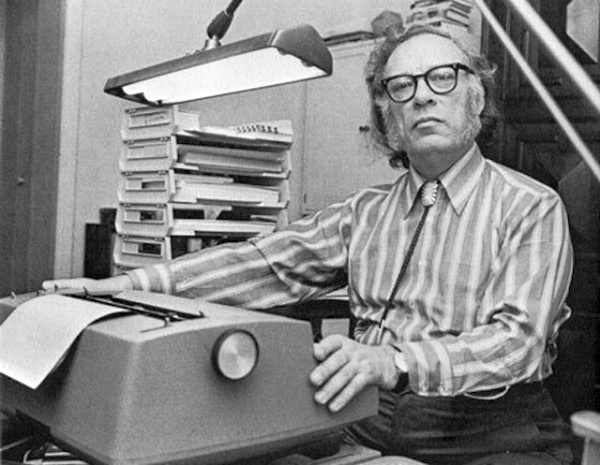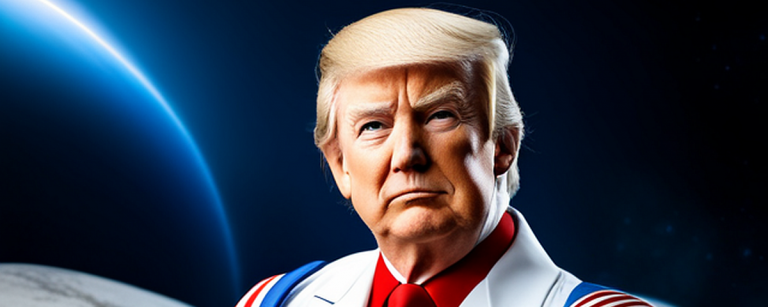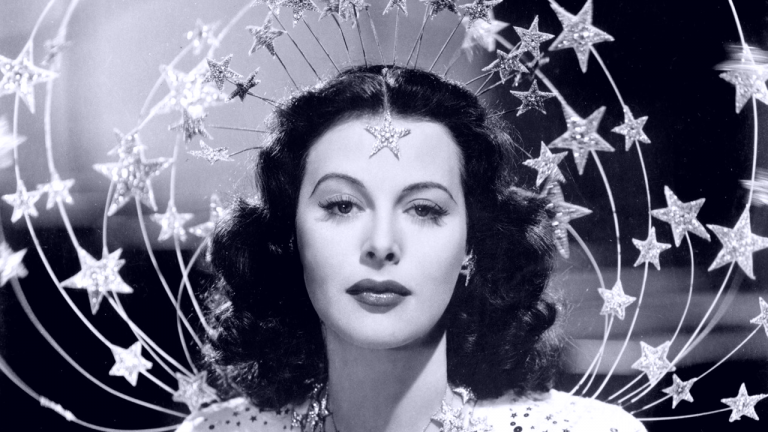Isaac Asimov (Исаак Азимов) was born in Petrovichi, Russian SFSR, in either late 1919 or early 1920; he celebrated January 2 as his birthday, and migrated from Russia to Brooklyn, N.Y., when he was a child. Asimov, along with Arthur C. Clarke and Robert Heinlein – each of whom has had a crater on the Moon named in their honor – are widely considered as the “Big Three” of science fiction. The Lunar crater Jules Verne C was renamed in Asimov’s honor.
This brief, forward-looking essay, “A Tourist’s Guide to the Moon,” was published in the New York Times (Section 10, Page 33) on January 10, 1982.

By ISAAC ASIMOV
It is the year 2082 and the Moon is a settled world. There are 50,000 people who consider themselves Lunarians and who accept the Moon as their home, and of these over 5,000 have been born here and have never visited Earth. Almost all of them live in Luna City, the chief town. When tourism is at its height the total population is well in excess of 100,000.
Lunarians view tourists with mixed emotions. On the one hand, tourists crowd the space lanes and, at times, overload the Moon’s living facilities – and the Moon, despite all the advances of the last century, is still not an open world. Its available air and water must be carefully recycled and every drop of water replacement (hundreds of thousands of gallons a year) must be imported.
On the other hand, the Lunarians are proud of their world, have an almost feverish desire to counter the stereotype of the Moon as a bleak and desolate place, and (let us admit) can make use of the money that tourists bring. Most are happy to answer questions and will go out of their way to make visitors feel welcome and comfortable.
Most tourists who arrive are First-Timers, people who have never before left Earth. Many book a popular two-week package that allows them eight days on the Moon. They arrive after a three-day journey in which they have experienced the thrills and inconveniences of weightlessness, and look forward with relief to reaching the surface of a world where up is up and down is down. Despite all indoctrination, however, they seem to expect only one kind of world: one with Earth’s surface gravity.
This misconception is heightened by the fact that every effort is made to give the Moon an Earth-like appearance. The ship does not land on the surface, which is undeniably bleak (though Lunarians never use the word and would prefer to banish it from the dictionaries). The ship sinks into a huge airlock, and the passengers eventually step into a large visitor’s entrance port, in which atmosphere, temperature and décor are completely Earth-like. What cannot be camouflaged, however, is the Moon’s surface gravity, which is one-sixth that of Earth.
Nothing, apparently, can prevent that from being a surprise to First-Timers. After the initial shock, the reaction is inevitably amusement, and a tendency to try walking, hopping or jumping, despite the large signs that ring every possible change on the message: ”Please do not run or jump, but wait quietly for processing.” Falls are frequent, but the low gravity usually prevents serious damage.
On Earth, we are unmanned by our longing for a pastoral past that never really existed; and that, if it had existed, could never exist again … on the Moon, there is no past to long for or dream about. There is no direction but forward.
Isaac Asimov
“The Gods Themselves”
The first day is usually a tedious one, for every visitor to the Moon must be thoroughly examined biologically and medically, despite the initial screening on Earth. No undesirable life forms of any sort – seeds, parasites, germs – are permitted on a world in which the ecological balance is carefully controlled.
And the first night is invariably a restless one as natural night movements tend to heave one upward unexpectedly. First-Timers quickly understand the reason for the padded barriers running along every edge of a Lunarian bed. Lunarian hotels are generally very comfortable and are otherwise closely modeled upon their Earth counterparts.
By the second day, most tourists are acclimated to the low gravity and are willing to venture out and begin exploring the Moon. For that purpose there are the Lunar vehicles which are so characteristic of the Moon that their stylized representation serves as the universally recognized symbol of our satellite as an inhabited world. In these sturdy and maneuverable rocket-powered vehicles, passengers would remain perfectly safe if they wore ordinary clothing, although regulations require them to wear spacesuits.
To be sure, these spacesuits are not the bulky and cumbersome affairs of the early astronauts (which are what the word spacesuit seems to imply to Earth people even today) but are remarkably little different from ordinary winter clothing, except for their impermeability, the oxygen cylinders discreetly attached and the arrangement whereby a helmet can be clicked tightly into place in one movement. Under ordinary conditions, the helmet is suspended from the chest – clumsy, but necessary under the rules.
There are two major areas on the Moon’s surface that are musts for First-Timers and these do not include any of the natural formations. There is a certain austere interest in the mountains and craters of the Moon, but there is no denying that old bromide: ”See one Lunar crater, and you’ve seen them all.” Tycho on this side of the Moon, and Tsiolkovsky on the far side, get their share of tourist attention, but there is frequently expressed disappointment. The fact is that Earth’s mountains are more rugged, and the icecaps on land and the complex life patterns undersea lend them a grandeur and interest the Moon cannot duplicate.
Not so the two major human additions to the Lunar landscape. First is the great Lunar mining complex at the Neil Armstrong rift. Almost every step in the mining process is automated and is operated by robots. Tourists view the complex at night, since it is not really practical to remain bathed in the heat and hard radiation of the Sun for any length of time, considering that there is no natural atmosphere to serve as protection.
Solar energy on the Moon is cheap, however, and the mining complex is well-lit. The ship lands on the lip of the rift and the tourists affix their helmets (each one of which is carefully examined by the stewards on board) and emerge to look down at the panorama. There is the vast pit which has been dug out through all the activity of seven decades, but within which there remains an almost unimaginable further supply of metal-rich ore. A never-ending chain of buckets moves along rails to the mass driver, where an electromagnetic field accelerates them and flings them out into space like the world’s largest slingshot.
The second sight, smaller but more intensely human, is the great Karl Jansky radio telescope on the far side of the Moon. This is also best viewed at night, and considering that day and night each last two weeks on the Moon, a tourist cannot see both the mining complex and the radio telescope without usually having to wait anywhere from two to ten days in between.
The radio telescope dwarfs anything of the sort on Earth or in space. It is a kilometer in diameter and, with its auxiliary equipment placed elsewhere on the far side, its effective diameter is virtually that of the Moon itself. This radio telescope has the full width of the Moon between itself and the Earth and is free of all but minor stray radio interference from space establishments. It has, in recent decades, detected several radio-wave patterns from nearby stars which may indicate the presence of extraterrestrial intelligence. (Astronomers are still arguing.) Tourists, led through the underground laboratories, watch with rapt attention as the needles mark out the delicate rise and fall of those microwave intensities that may indicate nonhuman intelligence.
Touring the underground microlife vats on the Moon interests many since nutrients are produced in great quantities here. It must be admitted, however, that the odors encountered in the gloomy chambers are not to the ordinary taste.
Nor, it must be said, is Lunarian food. Those Lunar restaurants that cater to the tourist trade advertise ”Earth-cooking” as a matter of course, but that means, at best, a rather mediocre and very expensive hamburger. Authentically Lunarian restaurants are more interesting, since they feature microorganismic seasonings, but these are not for everyone.
The tourist who acclimates quickly and can eat the largely vegetarian Lunarian specialties with some semblance of pleasure will find himself instantly popular – the Lunarians will consider him almost one of themselves. (Those traveling with children will probably find themselves limited to ”Earth-cooking,” however – almost no Earth- born child will accept Lunarian food without considerable trouble.)

Lunarian shows are famous and they are not for export since the low surface gravity is of the essence. Expert Lunarian gymnasts can perform ”gravity-defying” feats that are simply impossible on Earth, even for gibbons. Tourists cannot fail to be enthralled.
Skiing is the chief Lunar sport. Snow is not needed – under the low gravity, the body presses down against the gritty Lunar surface only lightly, and this reduces the friction to a large extent, making that surface surprisingly slippery. Add to this the manner in which professionals attach small cylinders of argon gas to their shins to produce a layer of gas under the boots which further decreases friction. Down the gentle slope of a Lunar crater and across the lunar surface (which invariably supplies sufficient unevenness to make an excellent obstacle course) the skiers race with incredible grace.
Invariably the more athletically-inclined of the tourists try their hand at it themselves, and though they are helped along, given easy equipment and gentle slopes, they just as invariably find that it is not as easy as it looks. Again, fortunately, the inevitable falls are not as hurtful as they would be on the Earth.
There is no question, though, that of all the tourist attractions on the Moon, that which is the most absorbing is the sky. Since the Moon has no atmosphere, there are no fogs, mists, smoke, or clouds to interfere with an always perfect view. From behind the high-transparency glass of an observatory, every star (non-twinkling) is about 25 percent brighter than it would seem on Earth. The planets, too, are brighter than we are accustomed to, and Venus, at its brightest, is almost mesmerizing in its brilliance.
Because of the Moon’s slow rate of rotation, the sky moves at only one-thirtieth the apparent speed of Earth’s sky. In a way, this is a disadvantage for one can get tired of an almost-unchanging view. On the other hand it allows a 14-day period of night before the Sun appears on the eastern horizon.
The Earth itself is always visible. It goes through all the phases of the Moon in the same order and the same time. It is, however, about 13 times larger in surface area and, when full, 70 times as bright as the full Moon is in our sky. Furthermore, it is covered with a swirling cloud pattern that is always changing and is endlessly fascinating to watch.
Eventually, the Sun appears in the east and direct viewing becomes impossible. Visitors must then watch the sky indirectly by means of a computerized-television set-up in which the Sun is selectively screened out. On television one can see the Sun cross the sky, in a two-week journey, and pass the Earth either above or below. As the Sun nears, the Earth becomes a thinner and thinner crescent and then, after the Sun has passed, the crescent widens again.
Every once in a while, the Sun passes behind the Earth so that its rays are blocked and do not reach the Moon. On the Moon, this eclipse is the supreme sight. The television is turned off and direct viewing is possible again. The Earth becomes a black circle in the sky, within which no star can be seen; a circle that is rimmed by a thin edge of brilliant red-orange light. The circle is nearly four times as wide as the full Moon appears to be in Earth’s sky.
When the Sun is centered behind the Earth, the circle is equally bright all around. There are bound to be clouds along the rim of the Earth so that the circle may be broken here and there and, at particularly unlucky times, hardly any of it may be visible. At lucky times, all of it may be visible.
In any case, an eclipse of the Sun, as seen from the Moon, produces a vision of a kind that can never be seen from the Earth. The beauty of it must be experienced for descriptions are never adequate. It is not surprising, then, that tourism is always heavy at times when an eclipse is scheduled. Astronomers can predict, far in advance, when these times will come but there is not much use in urging my readers to make their reservations now. All shipping space to the Moon at eclipse time is booked 20 years in advance.
A final word of caution: although most Lunarians are as honest as their day is long, beware the souvenir-mongers. Almost no souvenir you are offered is worth the money charged. Beware particularly the sidewalk vendors of ”moon rocks.” The implication is that something is being offered for sale that is export-forbidden, or that is very rare. This is almost invariably untrue and you will find that you have paid a lot of money for something you could pick up anywhere on the surface – and for which you will have to pay an additional fee for space transportation home.
If you must take something back, take photographs – using your own camera.






